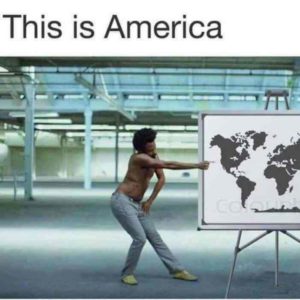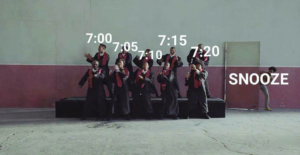More to memes than meets the eye
Childish Gambino’s 2018 music video, This is America, has been viewed 413 million times on YouTube, truly an embodiment of the term “viral video”. Although the highly symbolic and confronting video is tempting to discuss as a media object, it is the vast amount of memes which have been made from this video which are the most striking to me as media objects.
The video follows Gambino on a journey, covering poignant themes such as gun violence, racism, police brutality and the role that social media plays in present-day society. ‘Sadly it is 2018 and anything that is remotely popular, regardless of quality or content, will become a meme’. This is America is no exception. Looking at a selection of This is America memes, and memes more generally, the ways that memes are able to articulate and produce change, in addition to affecting spectators, will be explored.

What do memes aim to do?
A meme is a repurposed piece of popular media that has the ability to illustrate an thought, opinion or viewpoint, and that is shared on the internet. There are many aims of a meme. Sometimes they aim to be relatable, and subsequently shared. Other times, they aim to evoke an emotional response, or act as a form of social commentary, both of which can spark discourse. Memes are also a social phenomenon. They are constantly being created, often based on current cultural events, such as political interactions or in this case, music videos. Memes are a phenomenon also due to the wide range of emotional responses and discourse that can come from a singular meme.
Memes are more than this definition though, as illustrated by the memes in this article. They have the ability to communicate a range of information and navigate and touch on a diverse range of subjects, which extends beyond the image or video that is presented. The true complexity of memes lies in the existence, or absence, of knowledge regarding the original context of the media used. This means that the understanding of a meme may be influenced by a spectator’s knowledge of the image or video being used by the meme-maker.
Culture Jamming and media pirates
Culture jamming ‘is the act of reorganising media…in a way that gives new meaning to the images’. This helps to understand how memes have become a modern method of communication, a vessel of culture transmission. Memes and culture jamming both aim to repurpose images in a way which allows them to exist within a new frame of context. Kalle Lasn, from Adbuster, agrees saying ‘culture jamming and meme driven communication offer interesting windows on the transformation of politics and communication in our time’.
The transformation which Lasn refers to can be further understood through Zimmermann’s study of media pirates. These are people who take images, and decontextualize them ‘in order to reconceptualise them’. A meme-maker similarly, chooses an image, normally with its own significance, and then reconceptualises it by placing an alternate implication of a message onto the image.
Memes articulate their meaning by simultaneously representing both the original context of the image used, as well as the reconceptualised context of the meme itself. This duality means that the number of meanings that can be taken away from a meme is dependent on the spectator’s knowledge, and own opinion.

The meme above illustrates this, as this particular still from the music video has been repurposed to represent the battle with depression in an attempted humorous way. If a spectator has no knowledge of the music video and its implications, then they may see the meme for solely what it has been reconceptualised to be. However, someone with the knowledge that Gambino will eventually shoot the hooded figure, may view this meme as insensitive for both repurposing a brutal moment from the video and making light of depression.
Culture jamming, media pirates, and memes can be seen as coexisting in society, with a shared intention of reimagining content in a way that is intended to spark discourse. This discourse takes place on the internet, more specifically on social media sites such as Instagram and Twitter. Twitter’s mechanism of retweeting and liking content lends itself to creating viral content that is quickly, and easily, spread globally, generating mass discourse.

What drives a person to share a meme?
This meme above will be used to help understand why people share the memes that they do. We now know that memes are condensed images used to spark an emotional reaction. Memes often play on depicting relatable situations, such as the one above which plays with the action of snoozing an alarm. If a spectator finds an element in a meme relatable, this may lead them to sharing it.
Additionally, this meme above illustrates how different spectators are able to take away very different understandings from a meme. This meme is both a representation of the music video, as well as the reconceptualised meaning which the meme-maker has placed onto it. If the spectator has a knowledge of the music video, they may find the repurposing of such a poignant scene in the video to be distasteful, as it trivialises the American gun epidemic. If the spectator doesn’t recognise the video, then they may just take away from this meme what has been superimposed by the meme-maker. It becomes clear, that what a spectator takes away from a meme is dependent on their own knowledge and opinion.
Gambino has said that the internet is ‘the language of Earth…we are all connected to (it); but the thing is, there are no rules’. The uniqueness of memes is that there is no censorship of them, and no real accountability as they can be posted and shared under pseudonyms. This statement reiterates the fact that Gambino knew the risks involved with releasing any sort of media into society, where everything is subject to being re-purposed, re-imagined, and re-uploaded.
Through the creation of memes from This is America’s ‘most brutal moments, proves the exact point Glover is trying to make’, which is that society and the internet are so intertwined that it is inevitable that even the most symbolic and striking pieces of media will eventually be turned into memes. The irony lies with the ambiguity of the real meaning behind Gambino’s intentions, and perhaps he wanted memes to be made, as this helped to spark discourse and conversations about the video itself.
These three memes alone illustrate how images have the ability to elicit change and start discourse on major topics. On the surface, a meme can seem trivial, but through understanding the complexity that lies behind the actions of decontextualizing and repurposing an image and presenting it to the opinionated internet, showcases that there really is more to memes than meets the eye.
Bibliography
Evens, Greg. “People are furious that a This is America meme has gone viral”. Indy100. April 2018. Accessed October 12th, 2018. https://www.indy100.com/article/this-is-america-childish-gambino-donald-glover-meme-carly-rae-jepsen-call-me-maybe-8349676
Lasn, Kalle. Interview with Wendi Pickerel, Helena Jorgensen, and Lance Bennett. “Culture Jams and Meme Warfare: Kalle Lasn, Adbusters, and media activism”. April 19th, 2002. https://depts.washington.edu/gcp/pdf/culturejamsandmemewarfare.pdf
Nelson, Nate. “This is America memes are America”. Popdust. May 16th, 2018. Accessed October 12th, 2018. https://www.popdust.com/this-is-america-memes-2567692227.html
Washington Edu. “Culture Jamming and Meme-based communication”. Centre for Communication and Civic Engagement. Accessed October 13th, 2018. http://depts.washington.edu/ccce/polcommcampaigns/CultureJamming.htm
Weekes, Jabbari. “Childish Gambino discusses ‘because the internet’ and the complexity of web-era issues”. Exclaim. November 11th, 2013. Accesses October 13th, 2018. http://exclaim.ca/music/article/childish_gambino_discusses_because_internet_complexity_of_web-era_issues
Zimmermann, Patricia Rodden. “Pirates of the New World Image Order”. In States of emergency: documentaries, wars, democracies, 154-198. Minneapolis: University of Minnesota Press, 2000.
Image sources
